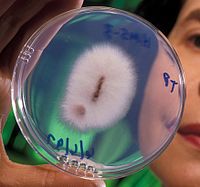
Photo from wikipedia
Safflower wilt, incited by Fusarium oxysporum f. sp. carthami (Foc) is one of the most devastating diseases of safflower. Virulence and genetic diversity of 90 Foc isolates representing four major… Click to show full abstract
Safflower wilt, incited by Fusarium oxysporum f. sp. carthami (Foc) is one of the most devastating diseases of safflower. Virulence and genetic diversity of 90 Foc isolates representing four major safflower growing states (Maharashtra, Karnataka, Telangana, and Madhya Pradesh) in India were analyzed. Out of 45 RAPD and 45 ISSR primers screened, 17 of each RAPD and ISSR markers revealed a comprehensive picture of genetic diversity. Primers depicting maximum heterozygosity, effective number of alleles, and Shannon information index were identified. Cluster and principal coordinate analyses distributed isolates from a given state among different clusters and quadrants, respectively, indicating high genetic diversity. However, certain region-specific groupings within clusters were found. The population structure comprised two sub-populations with admixture of alleles. AMOVA indicated maximum molecular variation within states (95%), and within races (79%). Among the six races identified on the basis of disease reactions on differential cultivars, Race 6 was the most virulent and Race 2 as the most prevalent. Groupings on the basis of molecular markers and geographical origin showed some degree of concurrence with the virulence of isolates. The findings are useful in screening of newly developed pathogen resistant varieties for the deployment of region-specific resistant cultivars of safflower.
Journal Title: Tropical Plant Pathology
Year Published: 2019
Link to full text (if available)
Share on Social Media: Sign Up to like & get
recommendations!